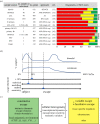When the Lyon(ized chromosome) roars: ongoing expression from an inactive X chromosome
- PMID: 28947654
- PMCID: PMC5627157
- DOI: 10.1098/rstb.2016.0355
When the Lyon(ized chromosome) roars: ongoing expression from an inactive X chromosome
Abstract
A tribute to Mary Lyon was held in October 2016. Many remarked about Lyon's foresight regarding many intricacies of the X-chromosome inactivation process. One such example is that a year after her original 1961 hypothesis she proposed that genes with Y homologues should escape from X inactivation to achieve dosage compensation between males and females. Fifty-five years later we have learned many details about these escapees that we attempt to summarize in this review, with a particular focus on recent findings. We now know that escapees are not rare, particularly on the human X, and that most lack functionally equivalent Y homologues, leading to their increasingly recognized role in sexually dimorphic traits. Newer sequencing technologies have expanded profiling of primary tissues that will better enable connections to sex-biased disorders as well as provide additional insights into the X-inactivation process. Chromosome organization, nuclear location and chromatin environments distinguish escapees from other X-inactivated genes. Nevertheless, several big questions remain, including what dictates their distinct epigenetic environment, the underlying basis of species differences in escapee regulation, how different classes of escapees are distinguished, and the roles that local sequences and chromosome ultrastructure play in escapee regulation.This article is part of the themed issue 'X-chromosome inactivation: a tribute to Mary Lyon'.
Keywords: X-chromosome inactivation; epigenetic regulation; escapee; inactive X chromosome; lupus; sexual dimorphism.
© 2017 The Author(s).
Conflict of interest statement
We declare we have no competing interests.
Figures

Similar articles
-
Structural aspects of the inactive X chromosome.Philos Trans R Soc Lond B Biol Sci. 2017 Nov 5;372(1733):20160357. doi: 10.1098/rstb.2016.0357. Philos Trans R Soc Lond B Biol Sci. 2017. PMID: 28947656 Free PMC article. Review.
-
Regulation of X-chromosome dosage compensation in human: mechanisms and model systems.Philos Trans R Soc Lond B Biol Sci. 2017 Nov 5;372(1733):20160363. doi: 10.1098/rstb.2016.0363. Philos Trans R Soc Lond B Biol Sci. 2017. PMID: 28947660 Free PMC article. Review.
-
Genes that escape from X-chromosome inactivation and sexual dimorphism of systemic lupus erythematosus.Yi Chuan. 2024 Jan 20;46(1):18-33. doi: 10.16288/j.yczz.23-214. Yi Chuan. 2024. PMID: 38230454
-
Mechanistic insights in X-chromosome inactivation.Philos Trans R Soc Lond B Biol Sci. 2017 Nov 5;372(1733):20160356. doi: 10.1098/rstb.2016.0356. Philos Trans R Soc Lond B Biol Sci. 2017. PMID: 28947655 Free PMC article. Review.
-
Progress in understanding the molecular mechanism of Xist RNA function through genetics.Philos Trans R Soc Lond B Biol Sci. 2017 Nov 5;372(1733):20160368. doi: 10.1098/rstb.2016.0368. Philos Trans R Soc Lond B Biol Sci. 2017. PMID: 28947663 Free PMC article. Review.
Cited by
-
Trio-binning of a hinny refines the comparative organization of the horse and donkey X chromosomes and reveals novel species-specific features.Sci Rep. 2023 Nov 17;13(1):20180. doi: 10.1038/s41598-023-47583-x. Sci Rep. 2023. PMID: 37978222 Free PMC article.
-
Estradiol, Progesterone, Immunomodulation, and COVID-19 Outcomes.Endocrinology. 2020 Sep 1;161(9):bqaa127. doi: 10.1210/endocr/bqaa127. Endocrinology. 2020. PMID: 32730568 Free PMC article. Review.
-
Sex Differences in HIV Infection.Curr HIV/AIDS Rep. 2018 Apr;15(2):136-146. doi: 10.1007/s11904-018-0383-2. Curr HIV/AIDS Rep. 2018. PMID: 29504062 Free PMC article. Review.
-
The eXceptional nature of the X chromosome.Hum Mol Genet. 2018 Aug 1;27(R2):R242-R249. doi: 10.1093/hmg/ddy148. Hum Mol Genet. 2018. PMID: 29701779 Free PMC article. Review.
-
CALRins5-mediated clonal hematopoiesis causes severe hemolytic anemia in a female PGK1Ser320Asn carrier.Blood Cancer J. 2025 Feb 1;15(1):8. doi: 10.1038/s41408-025-01216-w. Blood Cancer J. 2025. PMID: 39893164 Free PMC article. No abstract available.
References
Publication types
MeSH terms
LinkOut - more resources
Full Text Sources
Other Literature Sources
Medical

